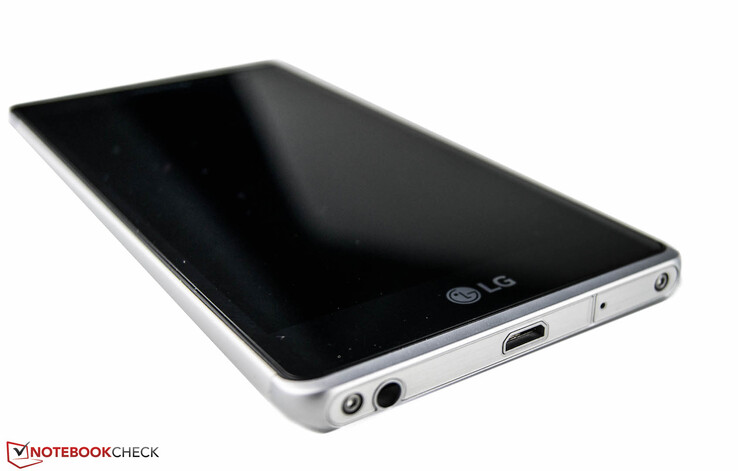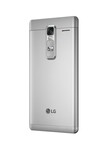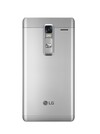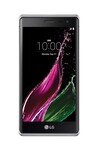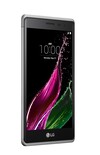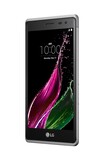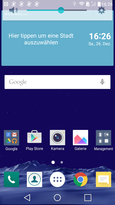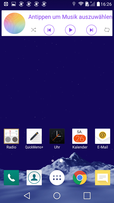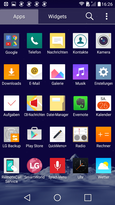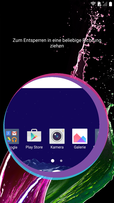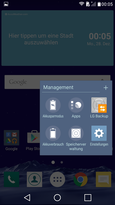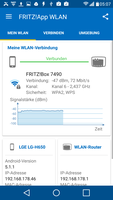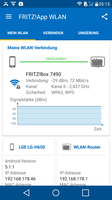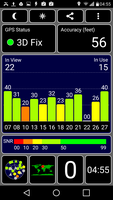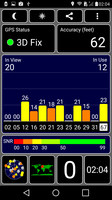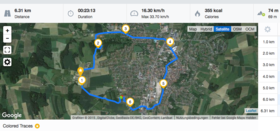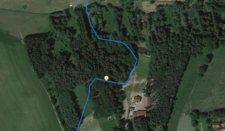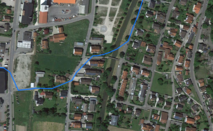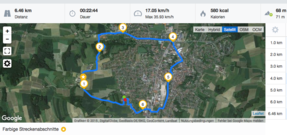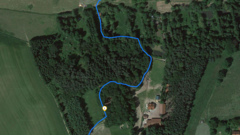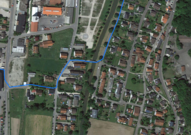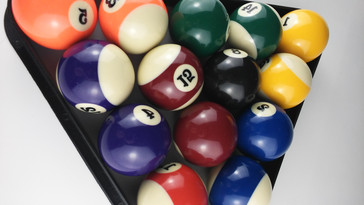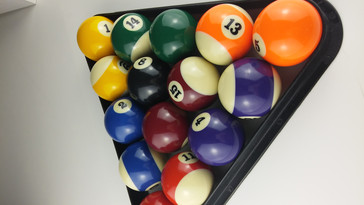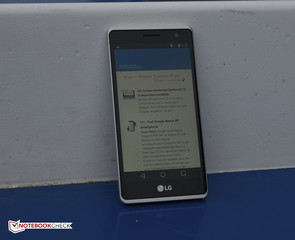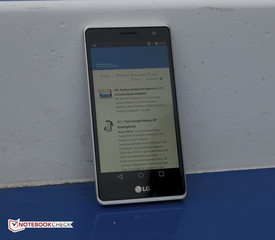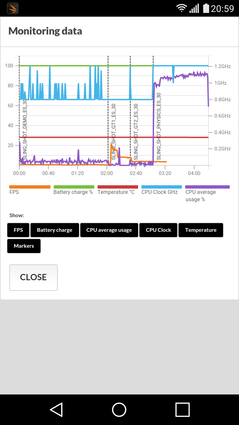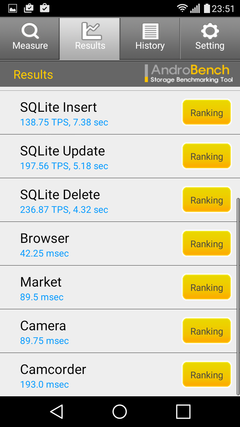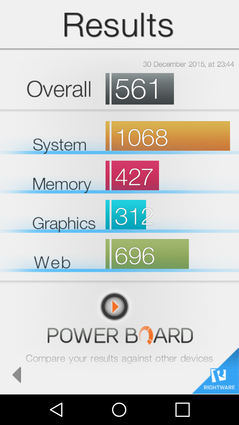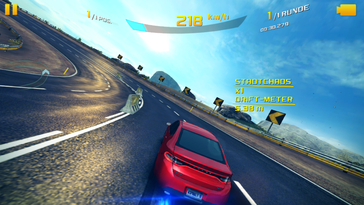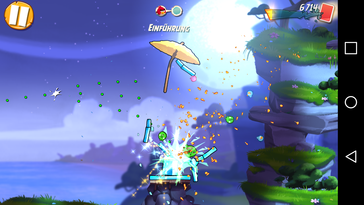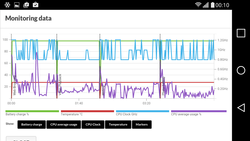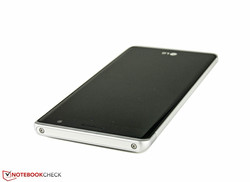LG Class (H650E) Smartphone Review

For the original German review, see here.
LG's Class smartphone comes to us just in time for the turn of the year. It is now also available in Germany. The main feature of the new lineup is the back made of aluminum for the first time. LG wants to especially perfect the feel and subjective impression when handling a smartphone with its Class. The manufacturer uses the appropriate word "harmony" for this. We set ourselves the task of examining the total package. The price has remained reasonable despite the premium materials. LG's class is available for 250 Euros (~$272). A quad-core processor, 1.5 GB working memory and 16 GB storage are inside. As usual, two cameras are installed. An HD camera serves as a selfie cam, and a 13 MP primary camera is situated on the rear.
We include some rivals in our test. The 280-Euro (~$304) Desire 626G comes from HTC, and Motorola's Moto G should also be present. ZTE's Blade V6 and Samsung's Galaxy J5 are in the same price range. The just recently tested Allview E4 and OnePlus X are also interesting.
Case
A special feature of LG's new Class is its casing. The manufacturer treats its smartphone lineup to a solid aluminum back cover for the first time. The color option is matte-sliver in our case; matte-gold is an alternative.
The smartphone's weight of approximately 150 grams makes it pleasant to hold and conveys a high-quality impression. It at least appears that it would survive minor drops without damage. The applied Gorilla Glass 3 should forgive smaller accidents even if drops do not belong to that category. The feel is also largely good. We particularly liked the display's beveled edges. All other edges are also smoothly rounded. The 250-Euro (~$272) smartphone thus makes a higher quality impression than many plastic rivals. Only the transition between the aluminum part and plastic element is not connected quite impeccably. That is, however, only noticed during very close contact, and our review sample might also be a single case. The Torx screws on the lower edge are not fitted perfectly, either.
As typical for LG, no buttons are installed on the sides. As usual, they are situated on the rear under the camera. These buttons as well as the camera jut out of the casing significantly. Users of other smartphone builders will have to get used to this positioning at first. It cannot be generalized whether this positioning strategy involves advantages or disadvantages.
We cannot yet provide any details about maintainability. We will have to wait and see to what extent the screws on our review sample can be released. It is not possible to access the innards, in particular the battery, directly.
Connectivity
A look at the technical specs show a Qualcomm Snapdragon 410 processor clocked at 1.2 GHz as the performance core. The SoC has four ARM Cortex A53 cores. In total, the processing unit is situated in the mid-performance category. The memory configuration of 1.5 GB RAM is standard. Many rivals only have 1 GB in this price range (HTC Desire 626G, Motorola Moto G3). However, Allview's E4 and ZTE's Blade V6 offer more. 16 GB of storage is installed. Unfortunately, there are no higher capacity storage options. Some rivals only provide 8 GB of storage. A micro-SD card slot allows expanding the storage. It supports memory cards with a capacity of up to 128 GB and supports App2SD, making it possible to move apps to the SD card.
As usual, the interfaces are limited to an audio jack and a USB port on the handset's lower edge. The SIM and SD-card slots are on the right. They can be removed with the included special tool. OTG allows connecting conventional keyboards and mice. Unfortunately, that was not possible with our review sample; the USB port only identified the USB storage device.
Software
LG's Class is shipped with Android 5.1.1 Lollipop. The desktop's looks largely correspond to the stock version and does not really include any visual modifications by LG. The corresponding button on the back or the touchscreen can be used for locking or unlocking the test smartphone via double-tapping the touchscreen. The display can be used for almost all actions. Since the manufacturer does not install any physical buttons, such as a home key, all interactions are performed directly on the screen.
A closer look at the installed software is not very surprising. Fortunately, LG does not bloat the 5-inch smartphone with third-party software. We like the folder "Management" placed on the home screen; it provides important information about the system, battery and backup data.
Communication & GPS
Three different wireless communication options are available. The first is via the mobile network; all common and up-to-date standards, such as LTE, UMTS, EDGE GSM, are supported. The module achieves theoretical gross rates of up to 150 Mbps (download) and 50 Mbps (upload).
The manufacturer installs Bluetooth 4.1 for using different headsets.
A Wi-Fi 802.11 a/b/g/n module is installed as the third and final two-way wireless connection. It operates in the 2.4 GHz network. Unfortunately, LG does not incorporate an NFC module. Other rivals, such as ZTE's Blade V6, feature this additional communication unit.
Before proceeding to the next receiver, we would like to name the installed sensors that are found in the Class smartphone: an accelerometer, a proximity sensor, a magnet-field sensor and an ambient light sensor. Not all belong to the standards in this price range. For example, the slightly more expensive Samsung Galaxy J5 doesn't offer a compass.
A GPS module is installed in our review sample for localization. Only a few seconds were needed for setting up a connection indoors (fourth and top story). However, the quality was rather middling. Tracking was much faster and more accurate outdoors.
Very evident deviations are seen in the GPS reception quality when directly compared with a Garmin Edge 500 bike computer. LG's Class proves to be almost as accurate as a professional system in single cases. However, major differences can be ascertained. For example, the review sample often located us beside the actual route according to the GPS tracker.
Telephone & Call Quality
The stock phone app of Android Lollipop is used for telephony. Tapping is accompanied by sounds and visual effects. Matching contacts are displayed almost instantaneously when entering number sequences.
However, its call quality is rather middling. Although the contact sounds loud and clear, the microphone installed in the review sample produces a somewhat muffled, slightly distorted sound. We used the more expensive iPhone 6s for reference. The call quality is overall still acceptable.
Speech rendering via the installed speaker is rather disappointing. Conversations sound distorted and much too quiet. It cannot drown out a slightly louder environment.
The included white in-ear headset makes a relatively cheap first impression. The build is inaccurate and imperfect in some places. It nevertheless fulfills its purpose. The ambient noise is suppressed. The quality during a test call is within the expected midfield. Its sound spectrum includes mids and has sufficient presence.
Cameras & Multimedia
A 13 MP primary camera with a resolution of 4160x3120 pixels is installed, which is also within the range of the competition. The rear-facing camera sports an f2.2 aperture, auto-focus and 4x digital zoom. The photo quality can be called solid although it lacks a bit of sharpness and contrast. That can be seen in the comparison screenshots of the smartphone camera in Apple's iPhone 6s below.
The front-facing camera has a relatively high resolution of 8 MP. Almost all comparison models have 5 MP. An f2.0 aperture is used here. Like in many other models, a fixed focus has to be accepted.
Accessories
The manufacturer does not include any really noteworthy accessories. The standard modular power supply, in-ear headset and a tool for removing the SIM card are the only extras. We did not discover any exclusive accessories on the manufacturer's page. Sleeves and covers are listed only for other models.
Warranty
The manufacturer does not reveal much about its warranty options. According to its general conditions, a 24-month warranty is included on tablets. Accessories are only covered for one year, and the battery is only covered for 6 months.
Input Devices & Handling
The primary input device of our review sample is the capacitive touchscreen. It detects up to ten fingers at a time and always responds quickly. Inputs are identified well up into the corners. Drag and drop also functions without problems. We did not experience delayed or jerky inputs during normal use.
LG's virtual keyboard is preloaded in our review sample. It can be configured in multiple ways. The most important are keyboard height, layout, swiping, word suggestions, text detection, feedback and visual modifications. The input device makes a good impression in portrait mode. It detects tapped letters without problems. We occasionally had to accept a short delay, which might annoy fast writers. The keyboard looks quite cramped in landscape mode, but that can be corrected in the options. Since LG does not install physical keys, the virtual keys limit the screen at the lower edge (for home button, etc.). That is particularly evident in landscape mode.
Display
LG installs a 5-inch screen that equals a diagonal of 12.7 cm in its new Class. The in-cell HD panel has an HD resolution of 1280x720 pixels. That results in approximately 294 pixels per inch, which is appropriate for the size and purchase price. LG's Class copes well even with direct light sources indoors and can always be used comfortably here. We measure an average brightness of 457 cd/m². Our review sample outshines its rivals with that. Lenovo's Tab 2 and Acer's Iconia Tab lag behind clearly with rates of around 350 cd/m². Medion's Lifetab S10345 is the taillight with 294 cd/m².
| |||||||||||||||||||||||||
Brightness Distribution: 91 %
Center on Battery: 518 cd/m²
Contrast: 1016:1 (Black: 0.51 cd/m²)
ΔE Color 5.41 | 0.5-29.43 Ø5
ΔE Greyscale 7.67 | 0.57-98 Ø5.3
Gamma: 2.19
| LG Class Adreno 306, 410 APQ8016, 16 GB eMMC Flash | OnePlus X Adreno 330, 801 MSM8974AA, 16 GB eMMC Flash | Motorola Moto G 3. Gen 2015 XT1541 Adreno 306, 410 MSM8916, 8 GB eMMC Flash | Samsung Galaxy J5 Adreno 306, 410 MSM8916, 8 GB eMMC Flash | Allview E4 Mali-T720 MP4, MT6753, 16 GB eMMC Flash | |
|---|---|---|---|---|---|
| Screen | -20% | 5% | -1% | 3% | |
| Brightness middle | 518 | 312 -40% | 418 -19% | 349 -33% | 534 3% |
| Brightness | 492 | 314 -36% | 407 -17% | 353 -28% | 503 2% |
| Brightness Distribution | 91 | 91 0% | 95 4% | 93 2% | 82 -10% |
| Black Level * | 0.51 | 0.49 4% | 0.57 -12% | ||
| Contrast | 1016 | 853 -16% | 937 -8% | ||
| Colorchecker dE 2000 * | 5.41 | 6.28 -16% | 3.92 28% | 5.22 4% | 5.65 -4% |
| Colorchecker dE 2000 max. * | 8.76 | ||||
| Greyscale dE 2000 * | 7.67 | 8.24 -7% | 3.81 50% | 3.96 48% | 3.69 52% |
| Gamma | 2.19 100% | 2.12 104% | 2.27 97% | 2.08 106% | 2.15 102% |
| CCT | 8521 76% | 8145 80% | 7361 88% | 7308 89% | 7289 89% |
* ... smaller is better
The colors and black tones look quite good in the automatic setting. Our test images also look relatively high-contrast purely subjectively. Black does not make a very saturated impression in maximum brightness. We measure a black level of a high 0.51 cd/m², which results in a contrast of 1016:1.
We analyze the colors and grayscale levels more precisely. A bluish tint is evident after only a while with the measuring instrument. CalMAN Grayscale also confirms that. The DeltaE shift of 7.67 is quite high for an IPS panel. It does not look much better in CalMAN ColorChecker with a shift of 5.41. Rivals, such as Samsung's Galaxy J5, do a better job with only half the shift.
A rate of 6500 K is considered the ideal color temperature. We measure a much higher rate of approximately 8500 K in our review sample.
Performance
A Qualcomm Snapdragon 410 APQ8016 is the performance core inside. This SoC (system-on-a-chip) is situated in the mid-performance category and incorporates four ARM Cortex A53 cores that are clocked at 1.2 GHz. The entire 64-bit instruction set is supported. The Qualcomm Adreno 306 GPU solution is also on board. Besides that, a 1.5 GB working memory supports the system. This configuration is similar to that of the competition (Motorola Moto G3), which is why it holds its ground quite well in the benchmarks.
LG's Class performs as expected in the benchmarks. Its scores are on par with the similarly built rivals from Motorola and Samsung as predicted. OnePlus' X proves to be a strong top performer and is clearly superior in all tests.
| GFXBench (DX / GLBenchmark) 2.7 | |
| T-Rex Onscreen (sort by value) | |
| LG Class | |
| Allview E4 | |
| OnePlus X | |
| Motorola Moto G 3. Gen 2015 XT1541 | |
| HTC Desire 626G dual sim | |
| 1920x1080 T-Rex Offscreen (sort by value) | |
| LG Class | |
| Allview E4 | |
| OnePlus X | |
| Motorola Moto G 3. Gen 2015 XT1541 | |
| HTC Desire 626G dual sim | |
| GFXBench 3.0 | |
| 1920x1080 1080p Manhattan Offscreen (sort by value) | |
| LG Class | |
| Allview E4 | |
| OnePlus X | |
| Samsung Galaxy J5 | |
| Motorola Moto G 3. Gen 2015 XT1541 | |
| on screen Manhattan Onscreen OGL (sort by value) | |
| LG Class | |
| Allview E4 | |
| OnePlus X | |
| Samsung Galaxy J5 | |
| Motorola Moto G 3. Gen 2015 XT1541 | |
| Geekbench 3 | |
| 32 Bit Multi-Core Score (sort by value) | |
| LG Class | |
| OnePlus X | |
| Motorola Moto G 3. Gen 2015 XT1541 | |
| HTC Desire 626G dual sim | |
| 32 Bit Single-Core Score (sort by value) | |
| LG Class | |
| OnePlus X | |
| Motorola Moto G 3. Gen 2015 XT1541 | |
| HTC Desire 626G dual sim | |
| 3DMark - 1280x720 Ice Storm Standard Score (sort by value) | |
| LG Class | |
| Allview E4 | |
| Samsung Galaxy J5 | |
| Motorola Moto G 3. Gen 2015 XT1541 | |
| HTC Desire 626G dual sim | |
Next, we would like to look at the system benchmarks. Our review sample also makes a very good impression here and is on par with the rivals. Only OnePlus' X again scores with its strong hardware.
| PCMark for Android - Work performance score (sort by value) | |
| LG Class | |
| Allview E4 | |
| Samsung Galaxy J5 | |
| OnePlus X | |
| Motorola Moto G 3. Gen 2015 XT1541 | |
| BaseMark OS II - Overall (sort by value) | |
| LG Class | |
| Allview E4 | |
| Samsung Galaxy J5 | |
| OnePlus X | |
| Motorola Moto G 3. Gen 2015 XT1541 | |
| ZTE Blade V6 | |
We use AndroBench for testing the transfer speeds. The read rates of LG's Class lag far behind its rivals. ZTE's Blade V6 achieves nearly twice as good results with almost 240 MB/s (sequential read). Then again, it is a bit more surprising that our review sample can stand up to the comparison models in the write tests. With a sequential write rate of approximately 74 MB/s, it scores twice as well as the just praised ZTE Blade V6.
| LG Class Adreno 306, 410 APQ8016, 16 GB eMMC Flash | Motorola Moto G 3. Gen 2015 XT1541 Adreno 306, 410 MSM8916, 8 GB eMMC Flash | ZTE Blade V6 Mali-T720 MP2, MT6735, 16 GB eMMC Flash | OnePlus X Adreno 330, 801 MSM8974AA, 16 GB eMMC Flash | Samsung Galaxy J5 Adreno 306, 410 MSM8916, 8 GB eMMC Flash | |
|---|---|---|---|---|---|
| AndroBench 3-5 | 9% | 47% | 51% | 15% | |
| Sequential Read 256KB | 128.6 | 131.4 2% | 269.3 109% | 235.5 83% | 145.5 13% |
| Sequential Write 256KB | 74.1 | 22.33 -70% | 37.37 -50% | 49.31 -33% | 39.4 -47% |
| Random Read 4KB | 9.67 | 22.79 136% | 27.08 180% | 16.31 69% | 19.25 99% |
| Random Write 4KB | 7.7 | 5.11 -34% | 3.66 -52% | 14.22 85% | 7.2 -6% |
Finally, a look at the browser benchmarks: LG's Class also performs as we desired and runs as fast as the installed hardware allows it to.
| Sunspider - 1.0 Total Score (sort by value) | |
| LG Class | |
| Allview E4 | |
| OnePlus X | |
| Samsung Galaxy J5 | |
| Motorola Moto G 3. Gen 2015 XT1541 | |
| ZTE Blade V6 | |
| HTC Desire 626G dual sim | |
| Octane V2 - Total Score (sort by value) | |
| LG Class | |
| Allview E4 | |
| OnePlus X | |
| Samsung Galaxy J5 | |
| Motorola Moto G 3. Gen 2015 XT1541 | |
| ZTE Blade V6 | |
| HTC Desire 626G dual sim | |
| Mozilla Kraken 1.1 - Total (sort by value) | |
| LG Class | |
| Allview E4 | |
| OnePlus X | |
| Samsung Galaxy J5 | |
| Motorola Moto G 3. Gen 2015 XT1541 | |
| ZTE Blade V6 | |
| HTC Desire 626G dual sim | |
| Google V8 Ver. 7 - Google V8 Ver. 7 Score (sort by value) | |
| LG Class | |
| Allview E4 | |
| OnePlus X | |
| Samsung Galaxy J5 | |
| Motorola Moto G 3. Gen 2015 XT1541 | |
| WebXPRT 2015 - Overall (sort by value) | |
| LG Class | |
| Allview E4 | |
| OnePlus X | |
| Samsung Galaxy J5 | |
| Motorola Moto G 3. Gen 2015 XT1541 | |
* ... smaller is better
Games
Although the performance of the installed Qualcomm Adreno 306 is limited, the mobile gaming world does not have to be avoided. Most games should be rendered with smooth frame rates. A lower graphics setting should be selected for more sophisticated games like Asphalt 8 Airborne. However, some occasional micro-stutters will have to be accepted.
Emissions
Temperature
Although an aluminum back always has a cooling effect, it can also pass heat quickly to the hands. We measure a rate of 30 °C almost everywhere in idle. A rate of 34 °C is only recorded in the area of the display unit. However, that is not disconcerting. Our review sample does not heat up distressingly under load, either. All temperatures remain below 40 °C. The hot spot of 38.6 °C is reached on the same spot as mentioned above. OnePlus' X can get palpably warmer with up to 47.5 °C. These maximum rates are only achieved in our stress scenario. The USB power supply also remains very cool with rates below 35 °C.
The CPU mostly clocks at 1.2 GHz in the full load scenario using Stability Test. Stutters are noticed every few seconds; the clock rates drop to 800 - 1000 MHz for a moment. A similar behavior was observed in the benchmarks we used in the chapter above.
(+) The maximum temperature on the upper side is 38.6 °C / 101 F, compared to the average of 35 °C / 95 F, ranging from 21.9 to 56 °C for the class Smartphone.
(+) The bottom heats up to a maximum of 35 °C / 95 F, compared to the average of 33.8 °C / 93 F
(+) In idle usage, the average temperature for the upper side is 30.1 °C / 86 F, compared to the device average of 32.7 °C / 91 F.
Speakers
The speaker was already a drawback in the Telephony chapter. Unfortunately, the poor sound quality is continued here. Music is extremely distorted and sounds unclear. The installed speaker is not suitable for more than some system sounds or messenger videos.
Energy Management
Power Consumption
The idle consumption of LG's Class ranges from 1.2 - 2.2 watts. That is on a good average level. OnePlus' X, for example, consumes a bit less. The reason is that the minimum brightness setting differs among the handsets. Allview's E4 is again the taillight in this round. It consumes up to 4.23 watts in idle. Our review sample requires 3.1 - 5.6 watts during load. Most rivals are on a similar level. Allview's E4 consumes one watt more. In contrast, OnePlus' X never needs more than 3.2 watts.
| Idle | |
| Load |
|
Battery Runtime
LG installs a battery with a capacity of 2050 mAh in our review sample. The manufacturer states a standby time of up to 340 hours and talk times of 360 minutes (2G) and 600 minutes (3G).
We perform a few battery life tests with LG's Class. The first test is to ascertain the minimum possible runtime. We set the brightness to maximum and initiate the Stability Test. The smartphone shuts down after approximately 3 hours and 16 minutes here.
We test the Internet-browsing runtime for simulating a real-world situation. The brightness is set to approximately 150 cd/m², and we enable energy-saving mode for this. The handset does a middling job with roughly seven hours. Motorola's Moto G and OnePlus' X are the leaders with up to 9 hours in this case.
Finally, we test the maximum possible runtime using minimum brightness and a Wi-Fi read script. LG's Class achieves 16 hours and 16 minutes here, which is on par with its rivals. Motorola's Moto G again stands out with a better runtime of 22 hours and 44 minutes.
| LG Class Adreno 306, 410 APQ8016, 16 GB eMMC Flash | HTC Desire 626G dual sim Mali-450 MP4, MT6592, 8 GB eMMC Flash | Motorola Moto G 3. Gen 2015 XT1541 Adreno 306, 410 MSM8916, 8 GB eMMC Flash | OnePlus X Adreno 330, 801 MSM8974AA, 16 GB eMMC Flash | Allview E4 Mali-T720 MP4, MT6753, 16 GB eMMC Flash | |
|---|---|---|---|---|---|
| Battery Runtime | -5% | 23% | 28% | -18% | |
| H.264 | 628 | 495 -21% | 677 8% | 514 -18% | 456 -27% |
| WiFi v1.3 | 422 | 398 -6% | 526 25% | 549 30% | 315 -25% |
| Load | 196 | 220 12% | 264 35% | 339 73% | 193 -2% |
Pros
Cons
Verdict
We were permitted to test LG's new Class and found the "harmony" that the manufacturer promises in some places. The casing's aluminum back conveys an elegant and robust impression. The icing on the cake for the looks is the beveled display edges. Unfortunately, we cannot speak of perfection. It lacks accuracy in many smaller areas. Nevertheless, only a few competing products of this price range can boast with a comparable choice of materials. The actual usage purposes should be kept in mind for a smartphone: making and taking calls. We expect better voice transmission and a better microphone in future. We are still shocked about the speaker. Apart from that, LG's Class always made its way through our test course on par with its rivals. The bright screen presents good-looking images and can also be used in bright outdoor conditions without problems.
The hardware inside is situated in the mid-performance category and scores as expected. The last crucial test sector is the battery life; our review sample also proved to be very average here.
In total, LG's Class is exactly what is it supposed to be: A solid mid-range smartphone with a superb casing.
It is difficult to decide if we could expect more especially in view of the price. Buyers who want more power and have financial reserves should look at OnePlus' X. However, other rivals are equals for our review sample. Therefore, Motorola's Moto G and the other opponents should also be considered.
LG Class
-
01/05/2016 v4.1(old)
Nino Ricchizzi


 Deutsch
Deutsch English
English Español
Español Français
Français Italiano
Italiano Nederlands
Nederlands Polski
Polski Português
Português Русский
Русский Türkçe
Türkçe Svenska
Svenska Chinese
Chinese Magyar
Magyar